Shooting wild creatures – that is, photographing them – is a delight to amateur nature enthusiasts as well as a great help to the research of biologists and conservationists, and hardware and software innovations have made capturing wildlife images easier than ever. Thanks to waterproof cameras, recording cameras and live networked cameras, plus selective motion sensors, humans can observe land and sea creatures in their natural environments. And once the pictures have been gathered, there’s even a program that can sift through them to keep only those with specified features.
Optical equipment manufacturers have specially adapted their digital cameras to allow amateur bird-watchers to grab close-up shots of birds from afar. Nikon Coolpix cameras can be used with the company’s fieldscopes for what is called “digiscoping,” during which a mechanical attachment positions the camera at the focal point of the telescope and excludes stray light so the automatic exposure control can work correctly. Using a Kyocera Finecam SL400R camera and adaptor kit with an Opticron ES 80 GA ED fieldscope – because the camera switches on rapidly and has a continuous-shooting mode that takes three full-resolution pictures per second – ensures that at least one of the pictures is in sharp focus and is centred on the target.

Hidden in a small log, the iCode device transmits images of these marsh harrier chicks through several kilometres of fibre to a computer running i-Catcher software. Courtesy iCode Systems Ltd.
The Royal Society for the Protection of Birds sells a kit that takes bird-watchers right inside the nest. It’s a bird nest box with a miniature video camera, and it delivers live images in colour or monochrome infrared night vision directly to the user’s television. There’s also a low-cost software package from iCode Systems Ltd. that converts a webcam into a wildlife observation system. Called i-Catcher Wildlife, it uses a motion detector to trigger the camera, and then a built-in Web server sends recorded sequences to the user’s computer. “A reserve deep in the Norfolk fens uses i-Catcher software to study the activity using a ‘time line’ – a bar graph covering 24 hours showing where motion occurs,” said Managing Director Huw Edwards. “Such tools are essential in wildlife footage with long periods of no activity. Live images displayed in the visitors’ centre allow elderly and disabled visitors to enjoy the wildlife.”
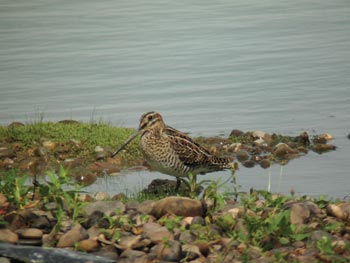
The snipe is a shy bird, but digiscoping allows the amateur to photograph it from a distance. Courtesy of Christine Connolly.
Such inexpensive systems may be sufficient for stationary or slow-moving subjects and for the everyday amateur photographer. But professional research projects often require more sophisticated equipment.
One great challenge in nature photography is to be in the right place – and get the right shot – at the right time. When the species is rare, fast-moving and confined to a remote region, this goes from challenging to nearly impossible. To attain their goals, researchers sometimes film continuously, using bait to attract animals. Scientists at the most recent International Deep Sea Symposium held in Southampton, UK, in 2006, reported nonstop monitoring via digital camera while disturbing the seabed to flush out the benthic creatures. Others used a towed camera to observe creatures in underwater canyons; still others have used satellite imaging to study whales.
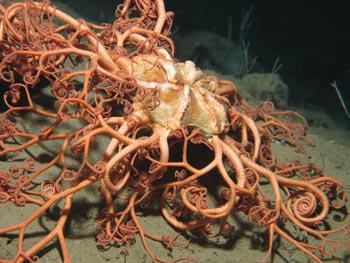
A remotely operated vehicle working from a semi-submersible drilling rig took this photograph of a basket star (euryalid ophiuroid) in the Norwegian Sea at nearly 1000-m depth. Courtesy of Dr. Andrew Gates, SERPENT project, www.serpentproject.com.
The SERPENT deep-sea project gives scientists access to the remotely operated vehicles (ROVs) used in the oil and gas industries, when they are not needed for normal operations. These high-specification vehicles have excellent imaging equipment such as the Kongsberg OE14-208 digital still camera mounted on a pan-and-tilt unit. The camera is a sturdy little number: It’s waterproof to a depth of 1500 m and withstands 30 g of shock. It also has automatic iris and focus control, stores hundreds of images with resolution up to 2272 × 1704 pixels and uploads images through a USB interface. The ROV imaging system also includes a flash unit, a colour video camera and a silicon intensified target low-light video system. SERPENT researchers can watch live images and capture stills at the appropriate moments.
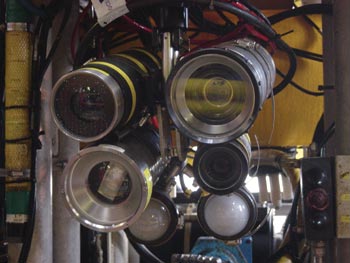
This close-up shows the Subsea 7 ROV imaging system, comprising the Kongsberg OE14-208 digital still camera and flash system, colour video, silicon intensified target low-light video and two video lights. Courtesy of Dr. Daniel Jones, SERPENT project, www.serpentproject.com.
Continuous filming cuts down on human input at the image acquisition stage, but it quickly generates a huge amount of data, and that data needs to be stored as well as viewed. It can take hours to find usable footage amidst the vast amount of waste. To tackle this problem, manufacturers have made smarter cameras, adding movement or body-heat sensors that trigger image capture and, in some cases, direct the camera on its pan-tilt-zoom (PTZ) mechanism. Eco-Watch designs and builds wildlife surveillance systems triggered by passive infrared sensors or pressure pads and has a waterproof high-resolution PTZ camera with remote control. Their eco-cube is a new product that records weather conditions and wildlife activity and makes the data available via a PC. Reconyx makes programmable wildlife surveillance cameras with passive infrared motion detection and infrared illumination, which begin shooting 100 ms after being roused from battery-conserving sleep mode. Integrated MapView Image Management software links the images to their geographical location, which is useful for animal tracking.
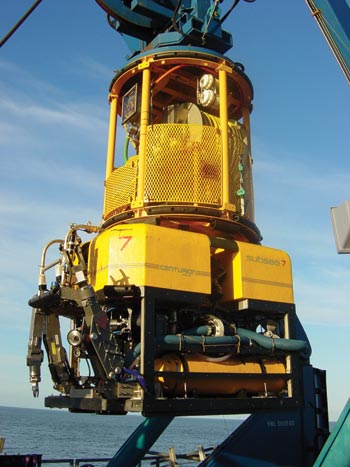
A Subsea 7 ROV is launched from an A-frame. The camera system and manipulator are at the lower left. Courtesy of Dr. Daniel Jones, SERPENT project, www.serpentproject.com.
One software innovation is expected to have a significant impact on the number of field hours put in by human observers during conservation endeavours. Developed by the University of California, Berkeley, in collaboration with Texas A&M University, it has been used in a long-term project run by the US Fish and Wildlife Service and the Cornell Lab of Ornithology to find the ivory-billed woodpecker. Although 6347 field hours were logged in the 2005-2006 season, there was not a single sighting; 59 trained volunteers continued the search in 2006-2007. Workers on the project record images with Reconyx cameras, using a selected frame rate with a good chance of capturing a relevant image within storage capacity limitations.
UC Berkeley and Texas A&M joined the effort in 2006 under a National Science Foundation project. To aid the volunteers’ efforts, the two universities have come up with ACONE, a high-resolution intelligent robotic video system, in which two cameras collect images of birds flying through a narrow power line corridor, and special software examines the images in real time, keeping those that show a large bird flying at 20 to 40 mph. The system already has captured some good images, and greatly improved the analysis.
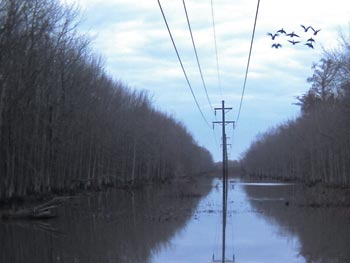
The ACONE system sorts images of birds flying along a power line corridor. The software searches for individual large birds but, in this case, was triggered by a flock of Canada geese. Courtesy of www.c-o-n-e.org/acone.
“The ACONE system automatically filters out 99.99 per cent of the video,” said Ken Goldberg, professor of engineering at UC Berkeley. “This reduced the workload on human experts, who analyzed the remainder and identified birds in 3 per cent of the samples, including high-resolution video of a red-tailed hawk and pileated woodpecker — but, so far, no images of the elusive ivory-bill.”